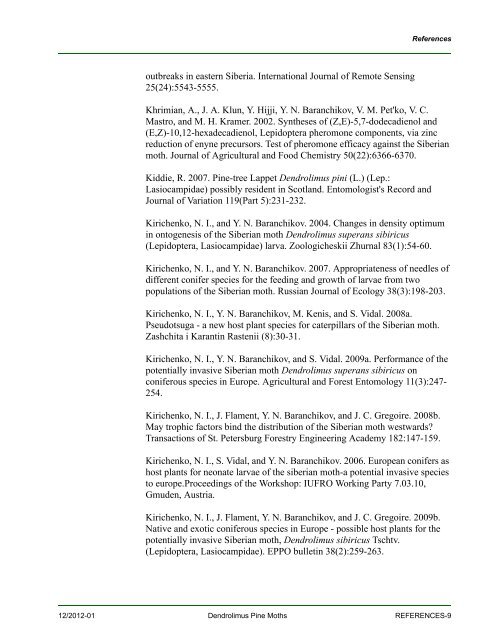New Pest Response Guidelines - aphis - US Department of Agriculture
New Pest Response Guidelines - aphis - US Department of Agriculture
New Pest Response Guidelines - aphis - US Department of Agriculture
You also want an ePaper? Increase the reach of your titles
YUMPU automatically turns print PDFs into web optimized ePapers that Google loves.
outbreaks in eastern Siberia. International Journal <strong>of</strong> Remote Sensing<br />
25(24):5543-5555.<br />
References<br />
Khrimian, A., J. A. Klun, Y. Hijji, Y. N. Baranchikov, V. M. Pet'ko, V. C.<br />
Mastro, and M. H. Kramer. 2002. Syntheses <strong>of</strong> (Z,E)-5,7-dodecadienol and<br />
(E,Z)-10,12-hexadecadienol, Lepidoptera pheromone components, via zinc<br />
reduction <strong>of</strong> enyne precursors. Test <strong>of</strong> pheromone efficacy against the Siberian<br />
moth. Journal <strong>of</strong> Agricultural and Food Chemistry 50(22):6366-6370.<br />
Kiddie, R. 2007. Pine-tree Lappet Dendrolimus pini (L.) (Lep.:<br />
Lasiocampidae) possibly resident in Scotland. Entomologist's Record and<br />
Journal <strong>of</strong> Variation 119(Part 5):231-232.<br />
Kirichenko, N. I., and Y. N. Baranchikov. 2004. Changes in density optimum<br />
in ontogenesis <strong>of</strong> the Siberian moth Dendrolimus superans sibiricus<br />
(Lepidoptera, Lasiocampidae) larva. Zoologicheskii Zhurnal 83(1):54-60.<br />
Kirichenko, N. I., and Y. N. Baranchikov. 2007. Appropriateness <strong>of</strong> needles <strong>of</strong><br />
different conifer species for the feeding and growth <strong>of</strong> larvae from two<br />
populations <strong>of</strong> the Siberian moth. Russian Journal <strong>of</strong> Ecology 38(3):198-203.<br />
Kirichenko, N. I., Y. N. Baranchikov, M. Kenis, and S. Vidal. 2008a.<br />
Pseudotsuga - a new host plant species for caterpillars <strong>of</strong> the Siberian moth.<br />
Zashchita i Karantin Rastenii (8):30-31.<br />
Kirichenko, N. I., Y. N. Baranchikov, and S. Vidal. 2009a. Performance <strong>of</strong> the<br />
potentially invasive Siberian moth Dendrolimus superans sibiricus on<br />
coniferous species in Europe. Agricultural and Forest Entomology 11(3):247-<br />
254.<br />
Kirichenko, N. I., J. Flament, Y. N. Baranchikov, and J. C. Gregoire. 2008b.<br />
May trophic factors bind the distribution <strong>of</strong> the Siberian moth westwards?<br />
Transactions <strong>of</strong> St. Petersburg Forestry Engineering Academy 182:147-159.<br />
Kirichenko, N. I., S. Vidal, and Y. N. Baranchikov. 2006. European conifers as<br />
host plants for neonate larvae <strong>of</strong> the siberian moth-a potential invasive species<br />
to europe.Proceedings <strong>of</strong> the Workshop: IUFRO Working Party 7.03.10,<br />
Gmuden, Austria.<br />
Kirichenko, N. I., J. Flament, Y. N. Baranchikov, and J. C. Gregoire. 2009b.<br />
Native and exotic coniferous species in Europe - possible host plants for the<br />
potentially invasive Siberian moth, Dendrolimus sibiricus Tschtv.<br />
(Lepidoptera, Lasiocampidae). EPPO bulletin 38(2):259-263.<br />
12/2012-01 Dendrolimus Pine Moths REFERENCES-9

















